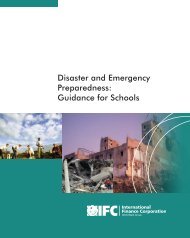Fragile States: Defining Difficult Environments for Poverty ... - INEE
Fragile States: Defining Difficult Environments for Poverty ... - INEE
Fragile States: Defining Difficult Environments for Poverty ... - INEE
You also want an ePaper? Increase the reach of your titles
YUMPU automatically turns print PDFs into web optimized ePapers that Google loves.
<strong>Fragile</strong> <strong>States</strong>: <strong>Defining</strong> <strong>Difficult</strong> <strong>Environments</strong> <strong>for</strong> <strong>Poverty</strong> ReductionSummary‣ In recent years, there has been a growing concern over the impact of weakor ineffective states. The range of problems associated with such states isbroad, including poverty, conflict and humanitarian crises, human rightsviolations, global security threats and weakened international systems.‣ <strong>Fragile</strong> states take many <strong>for</strong>ms, and have been defined in various ways.This paper adopts a definition of ‘difficult environments’ grounded in therole of the state in development effectiveness. <strong>Difficult</strong> environments aredefined as those areas where the state is unable or unwilling to harnessdomestic and international resources effectively <strong>for</strong> poverty reduction.This approach is intended to complement other analytical approaches tofragile states, including the work of the UK Prime Minister’s Strategy Unitproject on Countries At Risk of Instability. 1‣ Our definitional approach to state fragility looks specifically at thechallenges <strong>for</strong> development and poverty reduction. It is firmly located in theso-called Monterrey model of development, which calls <strong>for</strong> betterinternational partnerships to resolve today’s global human developmentchallenges. Although looking at specific responses to difficult environmentsis beyond the scope of this paper, we assume that states outside theMonterrey model will require different aid instruments and approaches.‣ The key challenge highlighted by this definition of difficult environments ishow to make development aid effective in places that lack basic levels ofstate capacity and commitment to poverty reduction.‣ By capacity we mean the core features that most strongly influence thestate’s ability to mobilise and use resources <strong>for</strong> poverty reduction,including territory control and presence, the effective exercise of politicalpower, basic competence in economic management and sufficientadministrative capacity <strong>for</strong> implementation.‣ When assessing the willingness of a state to engage in partnerships <strong>for</strong>poverty reduction, we are specifically looking at two closely relatednotions. First, an explicit political commitment to policies aimed atpromoting human welfare should be reflected in actions and outcomes. Inshort, political will <strong>for</strong> poverty reduction. And second, an inclusiveapproach that does not exclude particular social groups from the benefitsof development.‣ Based on these two key concepts, we present an indicative typology offour broad types of environments: 1) the ‘Monterrey’ cases of strongcapacity and reasonable political will, 2) the ‘weak but willing’ categorywhere government capacity is an obstacle to implementing policy, 3) the‘strong but unresponsive’ states where state capacity is directed toachieving development goals, and 4) the ‘weak-weak’ governments where1 http://www.strategy.gov.uk/output/Page5426.aspThis working paper is intended to stimulate public discussion. It is not necessarilyDFID or UK Government policy3
















